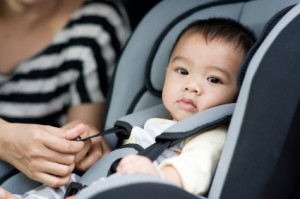

 Michigan’s Child Passenger Safety Law lays out age or height restrictions as well as how children must be safely secured in a car. Safely strapping in your children can prevent serious injuries or death if you and a child in your care are in a car accident.
Michigan’s Child Passenger Safety Law lays out age or height restrictions as well as how children must be safely secured in a car. Safely strapping in your children can prevent serious injuries or death if you and a child in your care are in a car accident.
Any child under 4 years old must be secured in a car seat in the rear seat unless there is no rear seat. If all rear seats are occupied by other children, then a child under 4 can be in a car seat in the front seat. If that seat is rear-facing, then the child may only ride in the front seat if the airbags are disabled.
Children must ride in a booster seat until they are either 8 years old or 4′9″ tall, whichever comes first. The State of Michigan recommends that a no-back booster seat for a seat that has a headrest. If the seat does not have a headrest, then the State of Michigan recommends a booster seat with a back. To properly use a booster seat, the child should be strapped in with a lap belt and a should belt.
Many have complained that the child safety rules are not specific enough to provide coherent guidance. As a result, in 2014 the Michigan Senate put forward Senate Bill 1135 and voted for more specific guidelines changing and outlining ages, types of restrain systems, and directionality. The bill died, however, once it reached the House of Representatives.
In 2014, the National Highway Traffic Safety Administration (NHTSA) put forth new recommendations for the Lower Anchors and Tethers for Children (LATCH) system. The LATCH system was originally created to make securing a child into a child seat easier. Previously, the NHTSA said that any child who weighs as much as 65 pounds should remain in a child seat or booster. However, this did not factor in the weight of the child seat or booster. The weight of the child combined with the weight of the child seat or booster was too heavy for car makers to guarantee the security of anchors holding the seat in place. Now, the NHTSA states that the combined weight of the child and seat should be no more than 65 pounds. Parents should weigh their child and child seats or boosters to double check the combined weight.
Parents and caregivers should make sure the seat or booster is properly installed in the car. A certified child passenger safety technician can check the seats or boosters and educate caregivers on how to properly strap in their children. Surprisingly, older children using booster seats are two times more likely to be seriously injured or die in a car accident than younger children in infant seats. This might be because parents worry less and booster seats are less intimidating to handle than car seats. At least one study found that booster seats are more often ignored during safety inspections other restraint systems. Risk for injury can be reduced 45% in children 4-8 years old when using booster seats properly.
Researchers also found that 9 out of 10 parents switched their children over to using booster seats instead of child seats far too soon. In case of an accident, children are at risk for “seat belt syndrome” that results in internal injuries in the abdomen, spinal cord injuries, and neck and face injuries.
Another potential hazard is the safety of the child seat or booster itself. If it has a design or manufacturing defect, the seat or booster could be a dangerous product. There have already been many recalls for defective car seats and boosters. However, to recover, you must show that the product fell short of recognized industry standards. You need a qualified and experienced attorney to assess whether you have a products liability case.
Our car accident attorneys at Sachs Waldman are passionate about child safety, and we will fight to get your child and your family the compensation you deserve. Contact our Detroit personal injury law firm today at (313) 965-3464 for a free consultation. We will take the time to discuss your unique case and advise you on the best course of action.
© 2024 Michigan Injury Attorneys
View Our Disclaimer | Privacy Policy
Detroit Personal Injury & Car Accident Attorneys